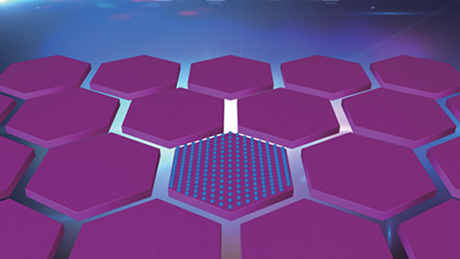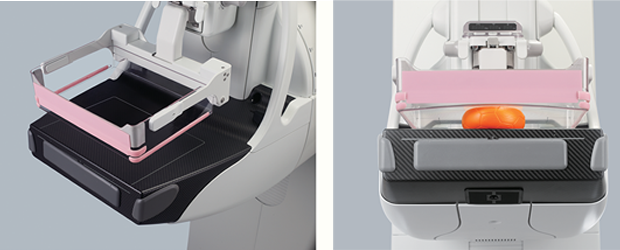Fujifilm’s “Aspire to Be Fearless” Campaign Highlights ASPIRE Cristalle with Digital Breast Tomosynthesis (3D Mammography)
FUJIFILM Medical Systems U.S.A. Inc. will offer 3D mammograms at no cost to underserved women through its “Aspire to Be Fearless” Campaign, featuring a mobile coach equipped with the ASPIRE Cristalle’s Digital Breast Tomosynthesis technology.
Fujifilm’s “Aspire to be Fearless” Campaign is bringing free advanced Digital Breast Tomosynthesis (3D mammography) screening to communities across the United States. The campaign will offer high-quality breast screening at no charge so women can fearlessly take charge of their breast health. Women from all walks of life will have a chance to experience a mobile mammography coach equipped with the ASPIRE Cristalle digital mammography system with DBT (Digital Breast tomosynthesis) and ASPIRE Bellus II mammography diagnostic workstation.

Fujifilm’s “Aspire to Be Fearless” Campaign centers on
a mobile mammography coach equipped with the ASPIRE
Cristalle digital mammography system with DBT (3D
mammography) to bring free DBT mammography
screening to communities across the United States.
Fujifilm’s “Aspire to Be Fearless” Campaign centers on a mobile mammography coach equipped with ASPIRE Cristalle digital mammography system with DBT (3D mammography) to bring free DBT mammography screening to communities across the United States.
ASPIRE Cristalle with Digital Breast Tomosynthesis (DBT)
ASPIRE Cristalle with Digital Breast Tomosynthesis (DBT) — or 3D mammography — combines Fujifilm’s state-of-the-art Hexagonal Close Pattern (HCP) detector design, and advanced image processing and image acquisition workflow to optimize patient dose while maximizing image quality. With ASPIRE Cristalle’s DBT technology, technologists and patients can experience superior diagnostic accuracy and lower recall rates for non-cancer cases.
“Hospitals and healthcare facilities are selecting the ASPIRE Cristalle because they want to elevate their patient satisfaction. And what they’re hearing from patients is that it truly is a better experience,” said Nicki Bryan, the National Director of Women’s Health Sales at FUJIFILM Medical Systems, U.S.A., Inc.

The unique Hexagonal Close Pattern (HCP) detector pixel
design on ASPIRE Cristalle digital mammography
system with digital breast tomosynthesis (DBT)
outperforms traditional pixel arrays and helps enable
superior diagnostic accuracy.
Hexagons are engineered to perform better than squares
The unique HCP detector pixel design on ASPIRE Cristalle outperforms traditional square pixel arrays in giving radiologists superior diagnostic accuracy and referring physicians improved confidence in developing patient treatment and management plans. It can also help reduce anxiety and fear in patients, who know they’re getting an accurate image and reading.
“Doctors are telling us that they do have a lot more confidence because they’re able to visualize things very quickly and very easily,” said Bryan.
HCP offers a 50-micron image display with an image turnaround time of only 15 seconds. The hexagonal pixels distribute the electrical field more efficiently than traditional square pixels to capture stronger signal with less noise, generating images with high detective quantum efficiency (DQE), which is related to image capture efficiency, and high modulation transfer function (MTF), which is related to spatial resolution. The result: Brilliant, exceptionally sharp image quality, even at low doses.
Patented Comfort Paddle designed to improve patient comfort during mammograms
ASPIRE Cristalle’s patented Comfort Paddle provides patients with noticeably less pain and anxiety, a key element that could help improve screening rates.

FUJIFILM’s ASPIRE Cristalle with DBT (3D mammography) features the patented Comfort Paddle, which
improves comfort for the patient, image quality for the radiologist and imaging ease for the technologist.
“Only 67% of women actually receive their screening mammograms on schedule, and one of the core reasons why this occurs is fear and apprehension about the exam itself. This is why we spend so much time and effort in developing features, such as our comfort compression paddle,” said Susan Crennan, Women’s Health Product Marketing Manager, FUJIFILM Medical Systems U.S.A., Inc.
This unique paddle distributes pressure more evenly and gently across the breast compared to conventional, flexible paddles, owing to its slotted paddle edge that allows the plate to flex with breast contours, bending from the center of the breast to the thinner edges. The paddle also tilts, permitting more gradual and even compression.
“We name it the comfort paddle for a reason. It’s much more comfortable than the current models that are out there. It flexes with the breast, which makes a more even compression, which in turn helps the radiologist get a better image. So it’s an all-around benefit,” said Rick Banner, Senior Director of Marketing, FUJIFILM Medical Systems U.S.A., Inc.
Efficiency for technologists and departments
ASPIRE Cristalle also simplifies and speeds workflow so technologists can focus more on patient care. ASPIRE Cristalle with DBT offers smart shortcuts and fewer clicks so technologists can set exposure and confirm images on a single screen while simultaneously adjusting density and contrast for both left and right views.
“Mammography technologists really appreciate the time-saving features and ergonomics. It’s very easy to manipulate with the touch of one button, it can be moved into different positions, and they can step through the exam on the workstation very quickly. We can customize it to their workflow. It’s a tool that gives them the ability to do the best job possible,” said Bryan.

The ASPIRE Cristalle with 3D mammography and ASPIRE
Bellus II mammography diagnostic workstation help clinicians
make the most of their 3D mammography capabilities.
Streamlined integration and image management
The ASPIRE Bellus II is Fujifilm’s latest generation workstation for women’s health. Combined with ASPIRE Cristalle with 3D mammography, it helps clinicians streamline workflow and optimize image displays so they can make a more precise diagnosis.
The attributes that make DBT so valuable to clinicians—such as their enormous data sets—can also put a strain on IT systems and cause significant study management challenges. That’s where the ASPIRE Bellus II comes in. The workstation offers advanced tomosynthesis viewing and Intellilink image analysis tools to enable rapid and precise reporting workflow. Direct integration with the ASPIRE Cristalle user interface takes department efficiency to a higher level, allowing advanced display tools and image access in line with that of reporting physicians, completely independent of the PACS system in use.
For more information about the Aspire to Be Fearless Campaign check out Twitter, Facebook and LinkedIn.
For information about the Fujifilm’s Aspire Cristalle Tomosynthesis Equipment visit https://www.fujifilmusa.com/products/medical/digital-mammography.
For Continuing Medical Education for Radiologists and Mammographers visit appliedradiology.org/6a